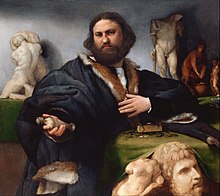




The Dutch Gift of 1660[1] was a collection of 24 mostly Italian Renaissance paintings, four by Dutch Masters, and twelve classical sculptures. The gift was presented to newly-restored King Charles II of England on 16 November by envoys of the States of Holland.[2]
Most of the paintings and all the Roman sculptures were from the Reynst collection, the most important seventeenth-century Dutch collection of paintings of the Italian sixteenth century, formed in Venice by Jan Reynst (1601–1646) and extended by his brother, Gerrit Reynst (1599–1658).[3] The gift reflected the taste Charles shared with his father, Charles I, whose large collection, one of the most magnificent in Europe, had mostly been sold abroad after he was executed in 1649.[4] Charles II was not as keen a collector as his father, but appreciated art and was later able to recover a good number of the items from the pre-war collection that remained in England, as well as purchasing many further paintings, and many significant old master drawings.[5]
Some decades later, there was a reverse movement when 36 paintings from the English Royal Collection, including at least one of those given in 1660, were taken by the Dutch King William III of England to his Dutch palace of Het Loo. His successor to the throne, Queen Anne, tried to recover these after William's death in 1702 but failed, and they mostly remain in Dutch public collections.[6] Fourteen paintings from the 1660 gift remain in the Royal Collection, with others now in different collections around the world.
- ^ See below for earlier gifts
- ^ Royal Collection, paintings acquired by Charles II
- ^ Emil Jacobs, "Das Museo Vendramin under die Sammlung Reynst", Repertorium für Kunstwissenschaft, 46 (1925:15–38), noted in Denis Mahon I p. 303 note 1. Mahon notes that the Reynst collection was as well known for its antiquities as for its paintings (Mahon p 304 note 14). See also Halbertsma on the sculpture, and Logan on the collection as a whole.
- ^ The tradition that many of the paintings had previously been in Charles I's collection, disseminated by George Vertue in the eighteenth century and often repeated was laid to rest by Denis Mahon 1949 — see Mahon I.
- ^ Lloyd, Christopher, The Queen's Pictures, Royal Collectors through the centuries, (National Gallery Publications) 1991, p. 75 ISBN 0-947645-89-6
- ^ Lloyd, p. 75